Famous Tibetan rugs
Tibetan rugs are famous for their intricate designs and vibrant hues, reflecting the rich cultural heritage of Tibet. They are considered among the top three prestigious carpets worldwide, showcasing traditional ethnic patterns that make them truly unique. The artistry and craftsmanship of Tibetan rugs have secured a special place in the realm of carpet weaving, passed down through generations to preserve the essence of Tibetan culture.
History and Culture
The narratives woven into Tibetan rugs encapsulate the historical interactions between Tibetan and Han communities, with origins dating back to the Ming Dynasty. Known for their superior quality wool, expert craftsmanship, and a wide range of color palettes, these rugs are admired for their distinctive link, especially the rod knotting technique that creates long tufts and dense piles characteristic of Tibetan rug making’s beauty.

Art and Tradition
Art exhibitions often highlight the color combinations and detailed weaving found in these rugs. Notably, standout motifs like dragons and phoenixes take center stage.
The intricate designs capture the eye with their beauty and carry deep cultural meanings, showcasing the blending of diverse ethnic heritages.
The fusion of dragon and phoenix elements in the artwork symbolizes the merging of influences and the peaceful coexistence of different traditions.
Everyday Utility and Artistic Value
Tibetan rugs have evolved from everyday pieces to revered art forms with profound cultural importance. In conclusion, originally categorized into temple rugs and domestic floor coverings, Tibetan rugs are now commonly found in households. The temple rugs include Zen meditation mats, ceremonial banner mats, ritual column mats, Vajra dance floor coverings, and door curtain mats. In contrast, domestic rugs encompass sitting mats, saddle covers, animal bedding covers, headgear for animals like horses and donkeys, as well as seat cushions. These rugs are a testament to the Tibetan people’s expertise and artistic skills that reflect their cultural legacy.

The blend of Contemporary and Traditional
Modern artists greatly appreciate Tibetan rugs for their timeless charm. The contemporary patterns adorning these rugs embody desires for a better future while maintaining the traditional simplicity reminiscent of Tibetan farmers’ way of life. Over the years, Tibetan rugs have transitioned from being possessions reserved for royalty and aristocrats to becoming household items used by regular individuals. This shift showcases how Tibetan rugs have evolved to meet modern requirements while still maintaining their traditional appeal. With their unique flair, Tibetan rugs remain highly valued both locally and globally, serving as symbols of the timeless heritage and cultural diversity of the Tibetan community.

